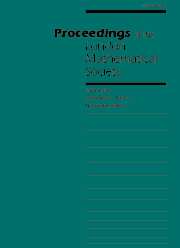Article contents
TRIANGLE GROUP REPRESENTATIONS AND CONSTRUCTIONS OF REGULAR MAPS
Published online by Cambridge University Press: 20 August 2001
Abstract
A regular map of type $\{m,n\}$ is a 2-cell embedding of a graph in an orientable surface, with the property that for any two directed edges $e$ and $e'$ there exists an orientation-preserving automorphism of the embedding that takes $e$ onto $e'$, and in which the face length and the vertex valence are $m$ and $n$, respectively. Such maps are known to be in a one-to-one correspondence with torsion-free normal subgroups of the triangle groups $T(2,m,n)$. We first show that some of the known existence results about regular maps follow from residual finiteness of triangle groups. With the help of representations of triangle groups in special linear groups overalgebraic extensions of ${\mathbb Z}$ we thenconstructively describe homomorphisms from $T(2,m,n)=\langle y,z|\ y^m=z^n=(yz)^2=1\rangle$ into finite groups of order at most $c^r$ where $c=c(m,n)$, such that no non-identity word of length at most $r$ in $x,y$ is mapped onto the identity. As an application, for any hyperbolic pair $\{m,n\}$ and any $r$ we construct a finite regular map of type $\{m,n\}$ of size at most $C^r$, such that everynon-contractible closed curve on the supporting surface of the map intersects the embedded graph in more than $r$points. We also show that this result is the best possibleup to determining $C=C(m,n)$. For $r\ge m$ the graphs of the above regular maps are arc-transitive, of valence $n$, and of girth $m$; moreover, if each prime divisor of $m$is larger than $2n$ then these graphs are non-Cayley. 2000 Mathematics Subject Classification: 05C10, 05C25, 20F99, 20H25.
Information
- Type
- Research Article
- Information
- Copyright
- 2001 London Mathematical Society
- 20
- Cited by

